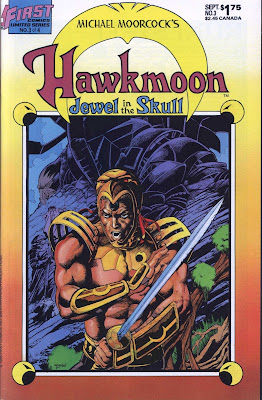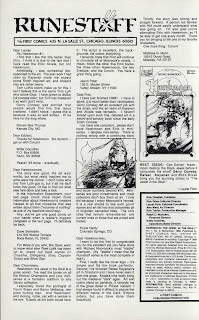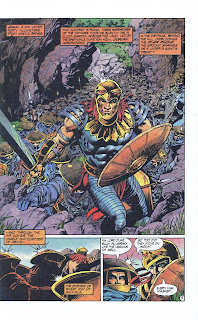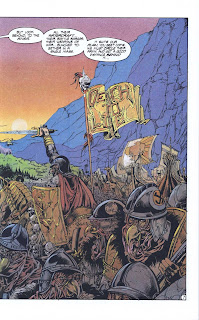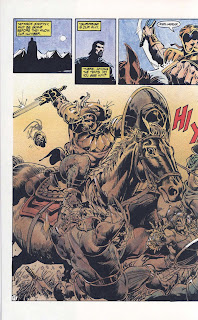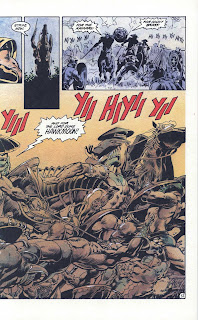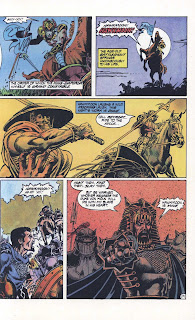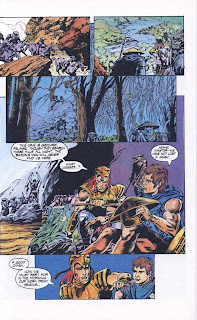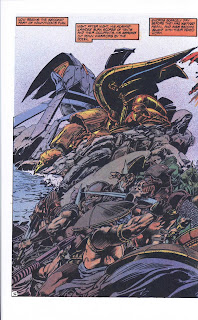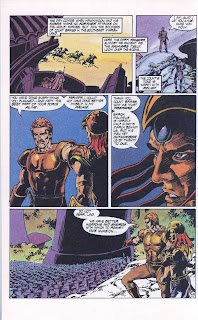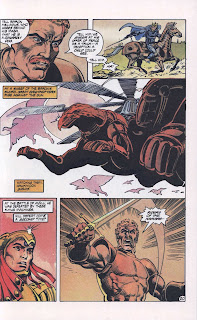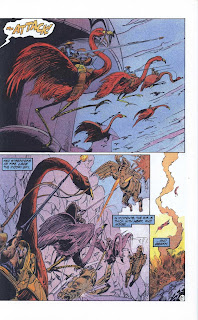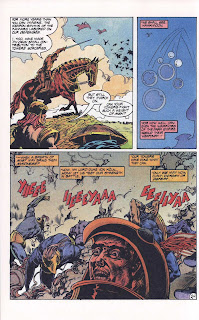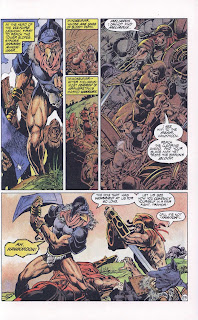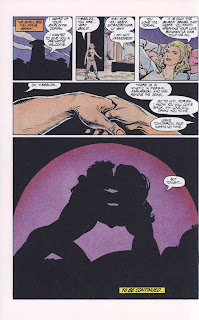from the book James Bama: American Realist by Brian M. Kane (Flesk Publications, 2006)
Saturday, June 10, 2017
A Gallery of Doc Savage Covers by James Bama
A Gallery of Doc Savage covers by James Bama
from the book James Bama: American Realist by Brian M. Kane (Flesk Publications, 2006)
from the book James Bama: American Realist by Brian M. Kane (Flesk Publications, 2006)
Labels:
Doc Savage covers
Thursday, June 8, 2017
Hawkmoon: The Jewel in the Skull issue 3
Hawkmoon: The Jewel in the Skull
First Comics, 1986
Issue 3 (September 1986)
art: Rafael Kayanan and Rico Rival, story: Gerry Conway
(Scans of issue one and issue two)
Artist Rafael Kayanan renders some outstanding battle sequences in this issue.......
First Comics, 1986
Issue 3 (September 1986)
art: Rafael Kayanan and Rico Rival, story: Gerry Conway
(Scans of issue one and issue two)
Artist Rafael Kayanan renders some outstanding battle sequences in this issue.......
Monday, June 5, 2017
70s French Sci-fi comics and Valerian
70s French Sci-Fi comics and Valerian
This July will see the release of the sci-fi film Valerian and the City of a Thousand Planets, produced and directed by Luc Besson and starring Dane DeHaan as the titular character, and Cara Delevingne as Valerian's sidekick Laureline.
Valerian was created by the writer Pierre Christin and the artist Jean-Claude Mézières in the French comic book magazine Pilote in 1967. The character became very popular and went on to regularly appear in albums de bandes dessinees (Franco-Belgian comic books) until 2010.
One of the Valerian comics was translated into English and published in Heavy Metal magazine in 1981 as "Valerian: Time-Space Agent: The Ambassador Of The Shadows", which is where and when I first became familiar with the franchise.
A very good essay on Valerian and other French sci-fi comics published during the 70s as albums desbandes dessinees, or as serials in comic book magazines such as Pilote and Pif, is available at this website. The essay, by Avi Abrams, indicates just how groundbreaking the artwork was, and its influence on sci-fi worldwide. For for example, Abrams points out how Mézières' artwork was a major source of inspiration for the Millennium Falcon from Star Wars.
Judging by the trailer, it looks like Valerian and the City of a Thousand Planets will stay true to the 'Gallic' sensibilities of the comics, and avoid being reworked into an American-style sci-fi film.
However, given that the Valerian comics relied more on satiric humor, political commentary, and a large cast of cutesy aliens, rather than the frenetic, violent action that defines American sci-fi movies, it remains to be seen how U.S. audiences will respond to Valerian and the City of a Thousand Planets..........
This July will see the release of the sci-fi film Valerian and the City of a Thousand Planets, produced and directed by Luc Besson and starring Dane DeHaan as the titular character, and Cara Delevingne as Valerian's sidekick Laureline.
Valerian was created by the writer Pierre Christin and the artist Jean-Claude Mézières in the French comic book magazine Pilote in 1967. The character became very popular and went on to regularly appear in albums de bandes dessinees (Franco-Belgian comic books) until 2010.
One of the Valerian comics was translated into English and published in Heavy Metal magazine in 1981 as "Valerian: Time-Space Agent: The Ambassador Of The Shadows", which is where and when I first became familiar with the franchise.
A very good essay on Valerian and other French sci-fi comics published during the 70s as albums desbandes dessinees, or as serials in comic book magazines such as Pilote and Pif, is available at this website. The essay, by Avi Abrams, indicates just how groundbreaking the artwork was, and its influence on sci-fi worldwide. For for example, Abrams points out how Mézières' artwork was a major source of inspiration for the Millennium Falcon from Star Wars.
Judging by the trailer, it looks like Valerian and the City of a Thousand Planets will stay true to the 'Gallic' sensibilities of the comics, and avoid being reworked into an American-style sci-fi film.
However, given that the Valerian comics relied more on satiric humor, political commentary, and a large cast of cutesy aliens, rather than the frenetic, violent action that defines American sci-fi movies, it remains to be seen how U.S. audiences will respond to Valerian and the City of a Thousand Planets..........
Saturday, June 3, 2017
Saucer Attack !
Saucer Attack !
by Eric Nesheim and Leif Nesheim
Kitchen Sink Press, 1997
Saucer Attack ! (128 pp) was published by Kitchen Sink Press in 1997.
The book was inspired by the large collection of 1950s toys and memorabilia collected over the years by the lead author and Madison, Wisconsin resident Eric Nesheim. With his son Leif recruited as a co-author, Nesheim wrote Saucer Attack as a homage to a memorable era in 50s pop culture in the U.S.
At 7 1/2 x 10 inches, this is not a coffee table book, nor even an 'art' book per se; but it is a quality book, with glossy paper and very good reproductions. Kitchen Sink Press always took care with quality of their books.
'Saucer Attack! has ten chapters, organized in rough chronological order, starting with the 1938 War of the Worlds broadcast by Orson Wells, and the increasing prominence of aliens and their spaceships in the Pulp Era of sf.
A subsequent chapter covers the signal event of the Flying Saucer Craze, businessman Kenneth Arnold's observation of flying saucers near Mt Rainier, Washington, in June 1947, which led to the explosion of interest in flying saucers that was a hallmark of the 50s and early 60s.
Remaining chapters deal with Flying Saucer culture in movies, television, print media, toys, and comics.
The Nesheims and their collaborators in the pop culture collector community have an impressive display of memorabilia within the pages of 'Saucer Attack !' Baby Boomers are sure to remember at least some of these items from their childhood days.
For me, it's seeing media from the classic TV show The Invaders that revives long-dormant memories.........I was only a kid at the time I watched it in the mid-60s, and I only have vague impressions of those few episodes I saw, but they made a lasting impression on me.
Interestingly, the flying saucer design used in The Invaders originated not with the show's production team, but in the memoirs of pioneering UFOlogist George Adamski (1891 - 1965), who in December 1952 released what he claimed was a photograph he had taken of an actual UFO (below).
Detractors scoffed that Adamski had simply repurposed some light bulbs and a surgical lamp......but True Believers in Flying Saucers held firm to the legitimacy of Adamski's claims. Needless to say, 'Saucer Attack' covers Adamski and other individuals who, in the 50s and 60s, paved the way for the 'contactee' and 'abductee' narratives that have become an integral part of pop culture.
by Eric Nesheim and Leif Nesheim
Kitchen Sink Press, 1997
Saucer Attack ! (128 pp) was published by Kitchen Sink Press in 1997.
The book was inspired by the large collection of 1950s toys and memorabilia collected over the years by the lead author and Madison, Wisconsin resident Eric Nesheim. With his son Leif recruited as a co-author, Nesheim wrote Saucer Attack as a homage to a memorable era in 50s pop culture in the U.S.
At 7 1/2 x 10 inches, this is not a coffee table book, nor even an 'art' book per se; but it is a quality book, with glossy paper and very good reproductions. Kitchen Sink Press always took care with quality of their books.
'Saucer Attack! has ten chapters, organized in rough chronological order, starting with the 1938 War of the Worlds broadcast by Orson Wells, and the increasing prominence of aliens and their spaceships in the Pulp Era of sf.
A subsequent chapter covers the signal event of the Flying Saucer Craze, businessman Kenneth Arnold's observation of flying saucers near Mt Rainier, Washington, in June 1947, which led to the explosion of interest in flying saucers that was a hallmark of the 50s and early 60s.
Remaining chapters deal with Flying Saucer culture in movies, television, print media, toys, and comics.
The Nesheims and their collaborators in the pop culture collector community have an impressive display of memorabilia within the pages of 'Saucer Attack !' Baby Boomers are sure to remember at least some of these items from their childhood days.
For me, it's seeing media from the classic TV show The Invaders that revives long-dormant memories.........I was only a kid at the time I watched it in the mid-60s, and I only have vague impressions of those few episodes I saw, but they made a lasting impression on me.
Detractors scoffed that Adamski had simply repurposed some light bulbs and a surgical lamp......but True Believers in Flying Saucers held firm to the legitimacy of Adamski's claims. Needless to say, 'Saucer Attack' covers Adamski and other individuals who, in the 50s and 60s, paved the way for the 'contactee' and 'abductee' narratives that have become an integral part of pop culture.
Scanning the books and comics and magazines showcased in the pages of "Saucer Attacks' will surely trigger some degree of acquisitiveness on the part of the reader. However, many of the pop culture artifacts on display are rare, and getting rarer, with each passing year, and thus getting quite expensive as a result.
All I can advise is that if, in your trips to used bookstores, or your examination of the boxes of older comics stored under the shelves in your local comics shop, you come upon some back issues of Western / Gold Key's UFO Flying Saucers, or Dell's The Outer Limits, or Eando Binder's Menace of the Saucers, you may want to grab them..........
Labels:
Saucer Attack !
Subscribe to:
Posts (Atom)




